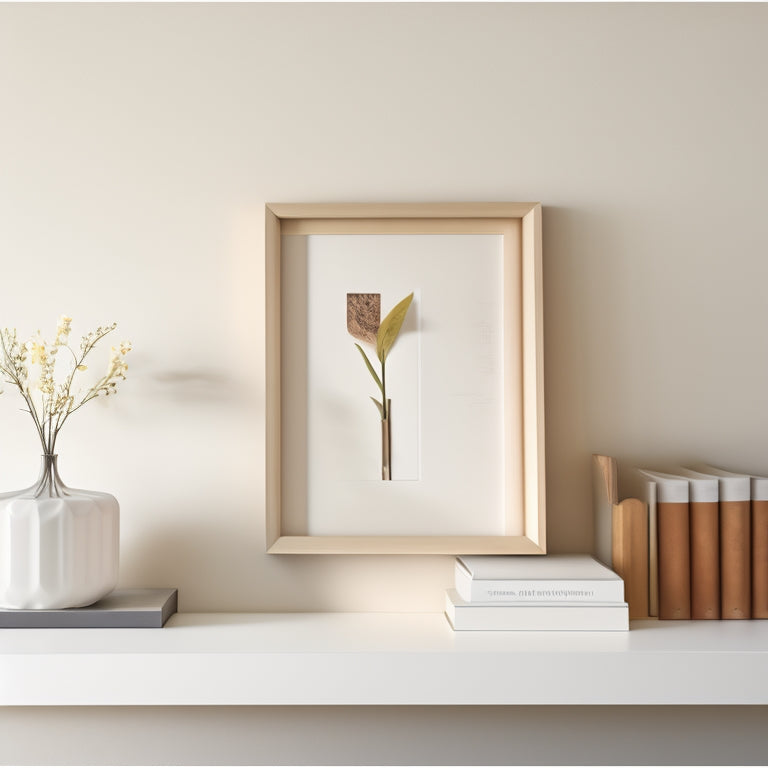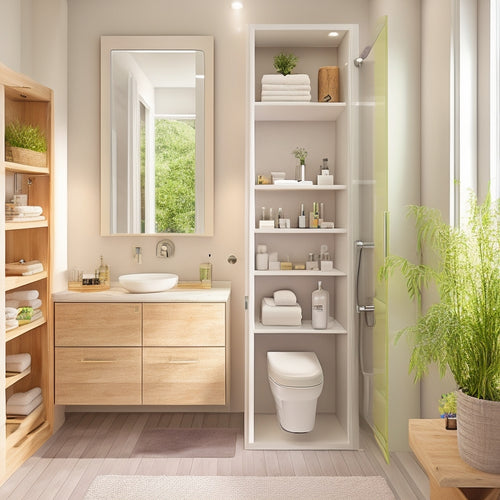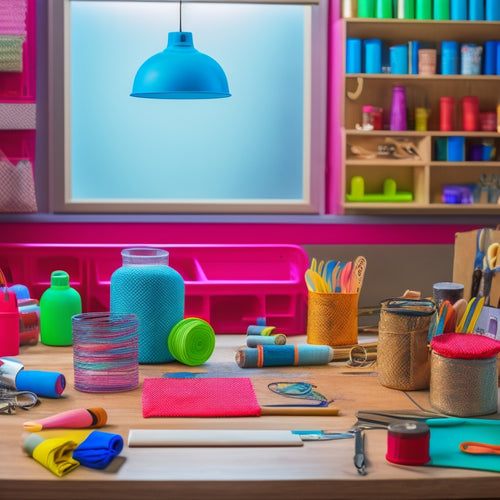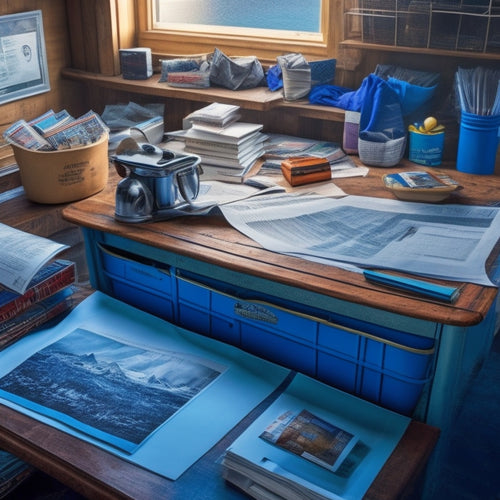
Decluttering 101: Taming Shelves for New Grads
Share
You're ready to trade in cluttered shelves for a serene, organized space that reflects your fresh start. Start by identifying bathroom clutter culprits, then sort items into keep, donate/sell, and toss piles. Invest in shower caddies for vertical storage and maximize storage to keep the shower floor clear. Next, assess your shelves and storage needs, categorizing items into functional groups. Create a labeling system for organization and separate usable goods from broken or outdated items. Now, get ready to discover more strategies to tame your shelves and maintain a clutter-free zone - and take the first step towards a more organized you.
Key Takeaways
• Identify clutter culprits and sort items into keep, donate/sell, and toss piles to declutter shelves and create a serene space.
• Assess shelves and storage needs by categorizing items and evaluating shelf contents for functionality.
• Implement storage solutions based on usage, allocating space efficiently for different item categories to maximize shelf space efficiency.
• Use labeling systems and shelf dividers to categorize and separate items, maintaining a clutter-free zone by putting things back in their assigned place.
• Schedule regular decluttering sessions and develop a consistent morning routine to sustain an organized bathroom and avoid clutter buildup.
Common Bathroom Clutter Culprits
As you step into your bathroom, you're likely to spot clutter hotspots like expired toiletries, tangled hair accessories, and a countertop cluttered with skincare products. Don't worry, we've all been there! It's time to tackle these common bathroom clutter culprits and transform your bathroom into a serene oasis.
First, take everything off your bathroom countertops and sort items into three piles: keep, donate/sell, and toss. Be ruthless – if you haven't used it in the past year, it's likely safe to get rid of it.
Next, consider investing in shower caddies to maximize vertical storage and keep shower essentials within easy reach. This will help keep your shower floor clear and prevent water from accumulating, making your bathroom a safer and more relaxing space.
Assessing Shelves and Storage Needs
It's time to take stock of your shelves and storage spaces!
Start by taking everything off your shelves and categorizing items into keep, donate, and toss piles.
This will give you a clear picture of your current storage situation and help you identify what you need to allocate space for.
Shelf Inventory Time
You're now standing in front of your shelves, ready to tackle the task of evaluating what's stored on them and what storage solutions you need to implement. This is your shelf reflection moment, where you take a step back, observe, and assess what's working and what's not. Take a deep breath, and let's get started.
Begin by scanning your shelves, noticing the items that catch your attention. What's visible, and what's hidden? Identify the items you use frequently and those that have been collecting dust.
Practice inventory mindfulness by being intentional about the items you've accumulated. Ask yourself: Do I still need this? Does it bring me joy or serve a purpose? Be honest with yourself – it's time to let go of items that no longer serve you.
As you assess your shelves, think about the storage solutions you need to implement. Consider the types of items you need to store, the frequency of use, and the available space. This is your chance to create a system that works for you, not against you.
Take your time, stay focused, and remember, every item has a home – it's time to find theirs.
Current Storage Situation
Now that you've taken stock of your shelf contents, it's time to assess your current storage situation, pinpointing areas that work and others that need improvement. Take a closer look at your shelves, cabinets, and closets. Identify what's working for you and what's not. Be honest with yourself – are there areas where clutter tends to accumulate? Are there storage solutions that just aren't cutting it?
Here are some key areas to examine:
-
Shelf capacity: Are your shelves overcrowded or underutilized?
-
Storage container usage: Are you using bins, baskets, or boxes effectively, or are they adding to the clutter?
-
Accessibility: Can you easily access the items you need, or are they buried beneath piles of other stuff?
- Flow and functionality: Do your storage systems make sense for your daily habits and routines?
Space Allocation Needs
With a clear understanding of your current storage situation, you can start allocating space more efficiently by identifying the types of items you need to store and the frequency of use. This is where room zoning comes in – dividing your shelves and storage into dedicated areas for specific categories of items.
For instance, you might have a zone for books, another for decorative items, and another for kitchen utensils. This helps maintain organization and makes it easier to find what you need.
When allocating space, consider the frequency of use. Store items you use daily in easy-to-reach areas, while less frequently used items can be stored in harder-to-reach areas or on higher shelves. A flexible layout is key, as it allows you to adjust your storage setup as your needs change.
Think about the items you'll need to access regularly, such as cleaning supplies or office materials, and allocate space accordingly. By allocating space thoughtfully, you'll create a functional and efficient storage system that makes your life easier.
Sorting and Purging Essentials
Now that you've assessed your storage needs, it's time to sort and purge your belongings.
You'll start by identifying items you no longer want or need, then categorize the remaining items into groups like 'keep,' 'donate,' and 'recycle.'
Identify Unwanted Items
As you stand in your newly acquired space, surrounded by the remnants of your college life, take a deep breath and tackle the challenging task of sorting through your belongings, separating the essentials from the unnecessary.
It's time to confront the emotional attachment you have to certain items and acknowledge the hidden guilt that comes with getting rid of them.
To start, gather items that fall into the following categories:
- Items you haven't used in the past year
- Items that no longer serve a purpose or bring you joy
- Items that are broken or damaged beyond repair
- Items that don't align with your current goals or values
Be honest with yourself – if you haven't used it in a year, it's likely you won't miss it.
Remember, the goal is to create a space that sparks joy and productivity, not clutter and stress.
Categorize Remaining Items
You're left with a manageable pile of essentials, and it's time to categorize them into groups that make sense for your new space and lifestyle. This step is pivotal in creating a functional and organized living area.
Begin by grouping similar products together, such as all cleaning supplies or kitchen utensils. This product grouping will help you visualize how you can optimize your storage space.
Next, create a labeling system that works for you. This could be color-coding, alphabetical order, or categorizing by frequency of use. Be consistent in your approach to avoid confusion.
Label each group clearly, so you can easily identify what's inside. Consider using storage bins or baskets with labels to keep items hidden from view.
Purge Unusable Goods
Sort through your essentials, separating items that are still usable from those that are broken, outdated, or no longer serve a purpose in your new life. Be ruthless – if you haven't used it in the past year, it's probably safe to let it go. Consider the items you've been holding onto 'just in case.' Ask yourself, 'Will I really use this again?' If the answer is no, it's time to let it go.
Some items that might be taking up valuable space in your life include:
-
Abandoned hobbies: That guitar you got on a whim but never learned to play? It's okay to admit defeat and pass it on to someone who'll actually use it.
-
Donated treasures: You might've received a lot of gifts over the years, but if you don't use or love them, consider passing them on to someone who'll appreciate them.
-
Outdated tech: Old phones, laptops, or gadgets that no longer work or are outdated? It's time to responsibly recycle them.
- Broken items: If it's beyond repair, it's time to say goodbye.
Categorizing Bathroom Belongings Effectively
Now that you've gathered all your bathroom belongings, categorize them into three piles: essentials, items to donate or sell, and items to toss. This sorting process is important in decluttering your bathroom space.
Your essentials pile should include items you use daily, such as your toothbrush, toothpaste, and any necessary medications. Be honest with yourself – if you haven't used it in the past month, it's probably safe to get rid of it.
In your morning routine, consider the Bathroom Hints that make your life easier. Do you have a favorite skincare product that saves you time? Keep it! Do you have expired or empty containers? Toss them!
Assigning Home to Each Item
With your categorized piles in hand, designate a specific spot for each essential item, ensuring everything has a deliberate place in your newly organized bathroom. This is where the magic happens – assigning a home to each item creates a sense of harmony and makes maintenance a breeze.
To make the most of your designated spaces, consider the following:
-
Group similar items together: Store all skincare products on one shelf, and haircare products on another.
-
Store items by frequency of use: Place frequently used items in easy-to-reach areas, and less frequently used items on higher or lower shelves.
-
Keep items in categories together: Store all oral care products in one area, and all body care products in another.
- Label each designated space: Use labels or stickers to identify where each item belongs, making it easy to find what you need and maintain your organized space.
Maximizing Vertical Shelf Space
You can greatly increase your bathroom's storage capacity by installing shelves or storage units that go up to the ceiling, enabling you to utilize the often-wasted vertical space. This will provide you with more room to store your essentials, keeping them organized and within reach.
To maximize this space, focus on efficient stacking techniques. Place heavier or less frequently used items at the bottom, with lighter or more frequently used items towards the top. This will prevent clutter from building up and make it easier to access what you need.
Shelf dividers can also be a game-changer in maintaining a tidy and organized space. Use them to separate items into categories, such as skincare, haircare, or medications. This will help you quickly locate what you need and prevent a jumbled mess.
Maintaining a Clutter-Free Zone
To keep your newly organized space from reverting to clutter, establish a daily routine that includes a few minutes of tidying up and putting away items after use. This habit will help you maintain a clutter-free zone and prevent the buildup of messes.
By dedicating a small portion of your day to tidying, you'll be able to enjoy the benefits of a peaceful and organized living space.
To make the most of your daily routine, remember to:
-
Put things back in their assigned place: This will help you develop a sense of discipline and responsibility.
-
Avoid impulse purchases: Be mindful of your consumption habits and only buy what you truly need.
-
Schedule regular decluttering sessions: Set aside time each week to get rid of items that no longer serve a purpose.
- Make it a habit: Consistency is key when it comes to maintaining a clutter-free zone.
Sustaining Your Organized Bathroom
Establish a 'home' for each bathroom essential, like your toothbrush and hair dryer, to guarantee everything stays organized and easy to find in your newly decluttered bathroom. This will help you maintain your space and avoid clutter buildup.
Next, develop a consistent morning routine to keep your bathroom organized and tidy. Allocate a specific time for your morning prep, and stick to it. This could be as simple as dedicating 10 minutes each morning to wiping down the sink, toilet, and shower, and restocking toilet paper and towels.
Frequently Asked Questions
How Do I Handle Sentimental Items That I No Longer Need?
"You're torn between holding onto sentimental items and letting go. Try Legacy Sorting: categorize items into keep, donate, and discard piles. Create a Memories Box for cherished keepsakes, and let the rest go, freeing yourself from emotional clutter."
Can I Declutter and Organize With Limited Budget and Resources?
You can declutter and organize on a shoestring budget! Try frugal hacks like repurposing items you already own, and get creative with DIY storage solutions to maximize your space without breaking the bank.
How Often Should I Declutter and Organize My Bathroom Shelves?
You should declutter and organize your bathroom shelves every 2-3 months, taking inventory of each shelf and dividing your bathroom into zones to maintain a clutter-free space that sparks joy and efficiency.
What if I Live With Others Who Don't Want to Declutter?
"Fearless declutterer, you face a familiar foe: Household Tensions. When sharing spaces with decluttering dinosaurs, set boundaries, communicate calmly, and focus on your own zones to minimize conflict and maximize your serene sanctuary."
How Do I Keep My Bathroom Organized While Sharing With Roommates?
You set roommate boundaries by designating personal spaces and shared storage, like a caddy for shared toiletries, to maintain harmony and keep your bathroom organized despite shared use.
Related Posts
-

Modular Bathroom Storage for Small Spaces
Modular bathroom storage is your go-to solution for small spaces, turning clutter into chic organization. Use wall-mo...
-

Craft Your Own Hanging Organizer With Ease
To craft a functional and stylish hanging organizer, begin by gathering essential materials, including natural cotton...
-

Newspaper Headline: Get Glacier Bay 3465HBHD Instruction Manual Now
The Glacier Bay 3465HBHD instruction manual is now readily available for download, providing users with a detailed gu...


